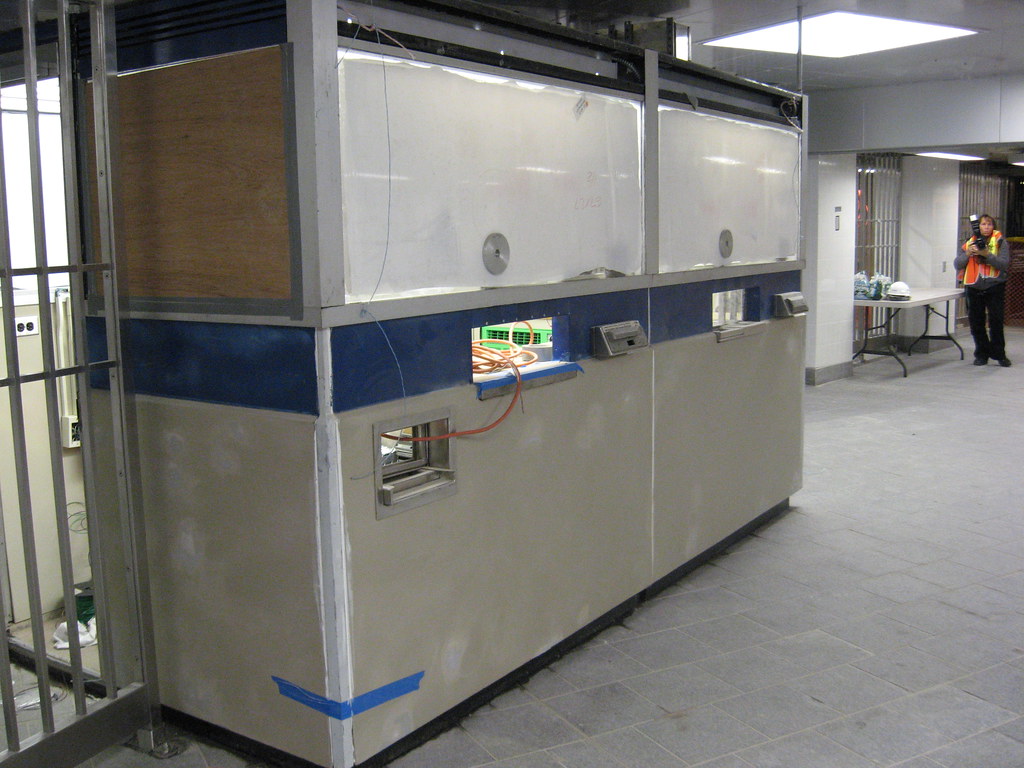A glimpse at the now-completed station agent booth at the new South Ferry Terminal. Will these booths slowly fade into obsolescence? (Photo by Benjamin Kabak)
Station agents and token booth clerks, those caged employees of the MTA, have been often in the news lately. Last week, a judge dismissed a complaint against two MTA employees — including one token booth clerk — who failed to stop a rape. The station employee tried to summon emergency help and did nothing egregious in violation of any duty to rescue, according to a Queens judge.
Meanwhile, if Albany doesn’t come through with an appropriate MTA funding package, as part of the Doomsday budget, the transit agency will be eliminating numerous station agents and shuttering token booths at the end of July. In fact, New York City Transit has already begun reducing staffing levels at booths around the system, and in light of concerns — spurred on by the increased attention to the rape case — over safety, the reception to these staffing cuts has been decidedly mixed.
Earlier this week, amNew York’s Heather Haddon reported on the non-staffing of some station agent positions. This state of affairs underground will become commonplace as the MTA is gearing to eliminate 800 station agents. Writes Haddon:
Last Wednesday, the MTA stopped replacing station agents who called out of work or took vacation. Those who asked for overtime to fill the spots were told it was unavailable for station agent posts, transit workers say. “It’s scary. They are not covering the jobs at all,” said Jacqueline Allison, a Wall Street station agent, who tried to work one of the vacant positions.
As a result, booths in at least a dozen stations across the city have gone empty during eight-hour shifts. Straphangers searching for information or needing help entering the subway must walk to another entrance…
Most of the entrances will remain open if an agent calls out of work, Fleuranges said. But in some cases, the turnstiles are gated, creating a bottleneck when passengers have to squeeze through one high-entrance turnstile.
Obviously, no one was happy with this. Critics bemoaned the personal safety aspect of this plan. Without station agents around, people will not be — or at least they won’t feel — as safe as they would like in the subway. I say “feel” because it’s rather dubious that the station agents have a protective purpose. At best, they deter would-be criminals from attacking a person or MTA property. The TWU has been pushing this view as a way to get these staffing cuts off the table.
Other critics — and I count myself in this group — believe that the MTA’s plan is a bit disingenuous. While station agent numbers will be reduced throughout the system, each station will be staffed with at least one employee at all times. What this means, however, is that for stations such as 50th St. on the West Side IRT that require separate entrances for uptown and downtown trains, only one side of the station will be staffed. For larger complexes that have multiple entrances, only some of the entrances will be staffed.
By the end of the week, New York City Transit had reneged on its decision to gate turnstiles at unstaffed stations. All entrances will remain open as scheduled even if the station stops are unstaffed, Transit said.
This decision though requires more automated fare-evasion enforcement. While cameras could have an impact, if no one is watching — and if everyone knows no one is watching — what will stop turnstile jumpers from leaping?
In the end, the lesson is obvious: The system can ill afford any cuts. Albany, I’m lookin’ at you.


11 comments
Often the token clerks or station agents defend their right to do nothing. A camera would make me feel safer.
Sometimes, they take away the station agent without much thought
Often the token clerks or station agents defend their right to do nothing. A camera would make me feel safer.
http://whatyourdonotknowbecaus.....ation.html
Sometimes, they take away the station agent without much thought
http://whatyourdonotknowbecaus.....nging.html
I was on the fence but I think now there IS a deterrent effect when the booths are fully staffed. It’s the same “eyes on the street” effect Jane Jacobs described decades ago, the same effect which makes traditional development safer than “towers in the parking lot”. One shocking, aberrant crime doesn’t change that fact but in fact reinforces it. Or at least I guess we’ll get our chance to find out if crime does increase in light of these cuts.
But crime might increase anyway. The newly unemployed station agents might become criminals.
I hope not.
What about PATH?
[…] a brand-new subway station booth at South Ferry — but will anyone ever staff it? Well, maybe they can rent it out as a studio. [Second Avenue […]
The MTA should instead hire all station agents as licensed security guards. That way they could do more than just sit in a booth and watch a crime as it happens, but they could handout fines, use physical force and have quick access to the police.
Just renaming the position “security guard” will do a lot psychologically. People often complain that token clerks don’t do anything, but if the position was titled “security guard,” they would be more understanding. Also, knowing that I can go to a security guard in case of an emergency makes me feel much safer than going to a token clerk.
Of course they’d now demand additional hazard pay for being security guards…
That rape story is infuriating.
[…] question has risen to the forefront in the Great Station Agent Debate of 2009. (More here, here and here.) The Straphangers Campaign has released results of a poll asking its members the following […]
Path is ok they only have 13 stations